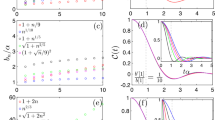Abstract
Run statistics denoting number of runs and sum of run lengths are defined on binary sequences and their asymptotic normality is established by a simple unified way for Bernoulli sequences. All the considered statistics share a common feature; they refer to runs of length exceeding a specific length (a threshold). Asymptotic results of associated statistics denoting run lengths and waiting times are derived as well. Specific probabilities of the examined statistics are used in applications in the fields of system reliability and molecular biology. The study is illustrated by an extensive numerical experimentation.
Similar content being viewed by others
References
Agarwal M, Sen K, Mohan P (2007) GERT analysis of m-consecutive-k-out-of-n systems. IEEE Trans Reliab 56: 26–34
Antzoulakos DL, Bersimis S, Koutras MV (2003) On the distribution of the total number of run lengths. Ann Inst Stat Math 55: 865–884
Balakrishnan N, Koutras MV (2002) Runs and scans with applications. Wiley, New York
Binswanger K, Embrechts P (1994) Longest runs in coin tossing. Insur Math Econ 15: 139–149
Boutsikas MV, Koutras MV (2002) Modeling claim exceedances over thresholds. Insur Math Econ 30: 67–83
De Moivre A (1756) The doctrine of chance, 3rd edn. Chelsea, New York
Demir S, Eryilmaz S (2008) Run statistics in a sequence of arbitrarily dependent binary trials. Stat Pap. doi:10.1007/s00362-008-0191-7
Eryilmaz S (2005) On the distribution and expectation of success runs in nonhomogeneous Markov dependent trials. Stat Pap 46: 117–128
Eryilmaz S (2006) A note on runs of geometrically distributed random variables. Discret Math 306: 1765–1770
Eryilmaz S (2007) Extension of runs to the continuous-valued sequences. Stat Probab Lett 77: 383–388
Eryilmaz S (2009) Mean success run length. J Korean Stat Soc 38: 65–71
Eryilmaz S, Demir S (2007) Success runs in a sequence of exchangeable binary trials. J Stat Plan Inference 137: 2954–2963
Feller W (1968) An introduction to probability theory and its applications, vol 1, 3rd edn. Wiley, New York
Fu JC, Lou WYW (2003) Distribution theory of runs and patterns and its applications: a finite Markov imbedding approach. World Scientific, New Jersey
Fu JC, Lou WYW (2007) On the normal approximation for the distribution of the number of simple or compound patterns in a random sequence of multi-state trials. Methodol Comput Appl Probab 9: 195–205
Fu JC, Lou WYW, Bai ZD, Li G (2002) The exact and limiting distributions for the number of successes in success runs within a sequence of Markov-dependent two-state trials. Ann Inst Stat Math 54: 719–730
Fu JC, Wang L, Lou WYW (2003) On exact and large deviation approximation for the distribution of the longest run in a sequence of two-state Markov dependent trials. J Appl Probab 40: 346–360
Godbole AP (1993) Approximate reliabilities of m-consecutive-k-out-of-n: failure systems. Stat Sinica 3: 321–327
Griffith WS (1986) On consecutive-k-out-of-n failure systems and their generalizations. In: Basu AP (eds) Reliability and quality control. Elsevier, North Holland, pp 157–165
Hirano K, Aki S, Kashiwagi N, Kuboki H (1991) On Ling’s binomial and negative binomial distributions of order k. Stat Probab Lett 11: 503–509
Hoeffding W, Robbins H (1948) The central limit theorem for dependent random variables. Duke Math J 15: 773–780
Kontoleon JM (1980) Reliability determination of r-successive-out-of-n:F system. IEEE Trans Reliab 29: 437
Koutras MV (2003) Applications of Markov chains to the distribution theory of runs and patterns. In: Shanbhag DN, Rao CR (eds) Handbook of statistics, vol 21. Elsevier, North Holland, pp 431–472
Kuo W, Zuo MJ (2003) Optimal reliability modeling: principles and applications. Wiley, New Jersey
Ling KD (1988) On binomial distributions of order k. Stat Probab Lett 6: 247–250
Lou WYW (2003) The exact distribution of the k-tuple statistic for sequence homology. Stat Probab Lett 61: 51–59
Makri FS, Philippou AN (1996) Exact reliability formulas for linear and circular m-consecutive-k-out-of-n:F systems. Microelectr Reliab 36: 657–660
Makri FS, Philippou AN (2005) On binomial and circular binomial distributions of order k for ℓ-overlapping success runs of length k. Stat Pap 46: 411–432
Makri FS, Philippou AN, Psillakis ZM (2007a) Polya, inverse Polya, and circular Polya distributions of order k for ℓ-overlapping success runs. Commun Stat Theory Methods 36: 657–668
Makri FS, Philippou AN, Psillakis ZM (2007b) Shortest and longest length of success runs in binary sequences. J Stat Plan Inference 137: 2226–2239
Makri FS, Philippou AN, Psillakis ZM (2007c) Success run statistics defined on an urn model. Adv Appl Probab 39: 991–1019
Makri FS, Psillakis ZM (1997) Bounds for reliability of k-within connected-(r, s)-out-of-(m, n) failure systems. Microelectr Reliab 37: 1217–1224
Martin DE (2005) Distribution of the number of successes in success runs of length at least k in higher-order Markovian sequences. Methodol Comput Appl Probab 7: 543–554
Mood AM (1940) The distribution theory of runs. Ann Math Stat 11: 367–392
Muselli M (2000) Useful inequalities for the longest run distribution. Stat Probab Lett 46: 239–249
Papastavridis S (1990) m-consecutive-k-out-of-n:F systems. IEEE Trans Reliab 39: 386–388
Papastavridis S, Koutras MV (1993) Consecutive-k-out-of-n systems. In: Misra KB (eds) New trends in system reliability evaluation. Elsevier, Amsterdam, pp 228–248
Roussas GG (1997) A course in mathematical statistics, 2nd edn. Academic Press, San Diego
Roussas GG (2007) Introduction to probability. Academic Press, San Diego
Scheaffer RL (1990) Introduction to probability and its applications. PWS-KENT Publishing Company, Boston
Author information
Authors and Affiliations
Corresponding author
Rights and permissions
About this article
Cite this article
Makri, F.S., Psillakis, Z.M. On runs of length exceeding a threshold: normal approximation. Stat Papers 52, 531–551 (2011). https://doi.org/10.1007/s00362-009-0268-y
Received:
Accepted:
Published:
Issue Date:
DOI: https://doi.org/10.1007/s00362-009-0268-y
Keywords
- Run
- Run length
- Waiting time
- Bernoulli trials
- Limiting distribution
- Asymptotic normality
- Reliability
- Statistical test



